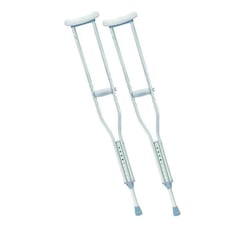I now know from first hand experience, that using crutches can be a blessing and a curse. Whilst they can help give you some freedom and comfort when injured, they can also become awkward, painful and more annoying than the injury itself!
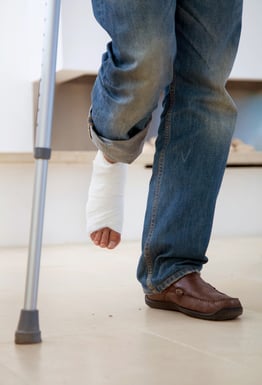
Recently, some of you may have seen me hobbling around the clinic on crutches. What a pain! After breaking a bone in my foot several weeks ago, I was given crutches and a boot by the hospital. Now I wish I could say the hospital took me step by step through how to set up my crutches and how to walk effectively and confidently, but to be honest it was more along the lines of "Here you go Dom, now avoid putting weight on your foot, and let's see you in two weeks".
Fortunately, working as a physio means I have a pretty good idea of how to use crutches, but I have had many patients come to me with similar stories of being given crutches with not much of a guide given as to how to use them. We often see clients in the clinic who have been given crutches who then struggle to use them. They then either never leave their home because moving around with crutches is too difficult, or they just stop using them and continue their daily life at the risk of delaying the healing of their injury.
So if you or someone you know is needing to use crutches, then sit down, rest up that injured leg and read my following guide for how to win life with crutches :)
Set up
The most common problem I see are crutches that are at an incorrect height and therefore can't provide the ideal amount of support. Crutches that are too high inhibit the effective use of your arms and lead to too much pressure causing chaffing and even damage to nerves/blood vessels in the arm pit. Crutches that are too low mean you will most likely be placing too much load through your injured limb which can delay your recovery.
There are two different types of crutches that your doctor or physio may have given you:
Underarm Crutches
https://www.essentialaids.com/aluminium-underarm-crutches.html
The underarm crutches are the most commonly used. They can come in different size frames, as well as those suitable for children, so before you just borrow your neighbor's crutches just check that they will be right for you. These crutches have both an adjustable leg length as well as hand position. The legs can be adjusted by pressing in the rods at the bottom and sliding the leg up or down accordingly.
How to fit them: When in standing (with your shoe one) the top of the crutches should be at the level of your armpit. To adjust the height, squeeze the two metal rods at the bottom of the crutch and slide the leg up or down accordingly. Once you have the correct general height, then we need to be more specific with our adjustment:
The height: Place the base of the crutches around 15cm out to the side of the feet. The height of arm padding should be around 3finger widths from the arm pit. In this position loosely bend your elbow, the handle height should be the same your wrist position.
Note: the crutches should not be pushing against your armpit when you are standing.
Forearm Crutches
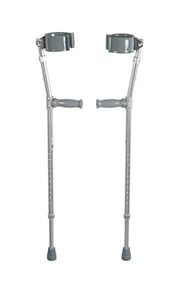
https://www.totalmobility.com.au/product/forearm-crutches/
Forearm crutches can be a little bit easier to adjust and set. When standing (with your shoe on) have the elbows slightly bent at about 30degrees. In this position the handle should match up with the crease lines on your wrist. Next is the open cuffs, find the widest part of your arm and the cuffs should sit 2finger widths below this part of the arm. Make sure your arms go into the cuffs.
Walking:
How you walk depends mainly on whether the doctor has told you whether you are non-weight bearing or partial weightbearing. When walking it is important to also use your arms and not rest on the armpits as this can injure nerves and blood in your armpit.
Non weight bearing status:
Non weight bearing means you are not allowed to stand on your injured leg at all, hence when you use crutches the injured leg will stay bent behind you. When you walk:
-
Place the crutches about a foot in front of you and out to the side.
-
Begin to move as though you were going to take a normal step with your injured leg, but instead slowly shift your body weight forward between the crutches.
-
Then step normally with your uninjured leg.
-
Finish by moving your crutches forward and out to the side again in preparation for your next step.
Partial weight bearing status:
Partial weight bearing means you can place some load through your leg. The aim with partial weight bearing is still to have most of your weight supported by either your uninjured leg or the crutches. Move the crutches forward first (place them as around the distance of a normal step, but also slightly wider than your shoulders) so that you make a tripod with the crutches and your uninjured leg. Bring your injured leg to come in line with the crutches, then shift your body weight onto the crutches and swing your body so your uninjured leg falls in just past the line of the crutches. Try not to hop, it should be a smooth transition of your body weight as opposed to hopping.
Stairs:
With stairs if you can remember: “good leg to heaven, bad leg to hell” this help remind you of the movement pattern:
Upstairs: Move the uninjured leg up the step first, then bring the injured leg and crutches up afterwards
Downstairs: bring the crutches down fist with the injured leg, followed by the uninjured leg.
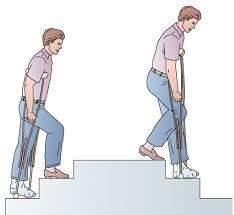
http://what-when-how.com/wp-content/uploads/2012/08/tmp61b683_thumb222.png)
How to get in and out of a chair:
Giving someone two large objects and asking them to sit in and out of chair is not the easiest of tasks (especially with an injured leg). But if you follow this technique it will be a lot easier.
Sitting in the chair: shuffle back till you feel the chair against the back of your knees, place both crutches on your injured side and you’re your free hand to feel for the armrest and slowly lower yourself onto the chair.
Getting out of the chair: hold both crutches with the arm on the injured side, use your other hand to help push up off the chair and stand onto your good leg. Once you are up on the good leg then pass one crutch to your other hand and your ready to go.
Getting into the car:
Getting into the car is similar to sitting down on a chair, except you hold onto the either the dashboard or car frame (depending on side of injury). Watch for your head and slowly lower yourself into the seat. Try to use your hands to help lift the injured leg into the car (or hook your good leg behind the injured leg to help bring it over into the car).
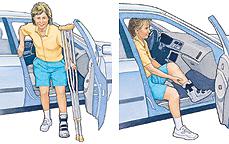
https://www.saintlukeskc.org/health-library/using-crutches-sitting-standing-through-doors
Hopefully this guide helps to relieve some of the stress in using crutches and can help you regain some freedom despite your injury. If you want any further advice or help with fitting any walking aids (crutches, boots, walkers) then please feel free to contact our physio team at BJC.

